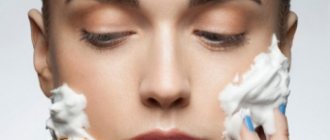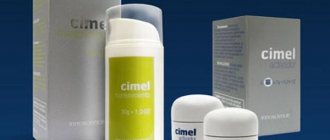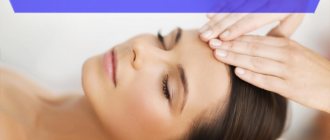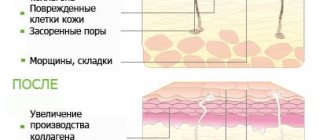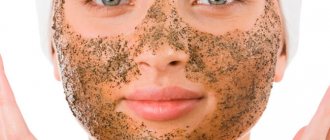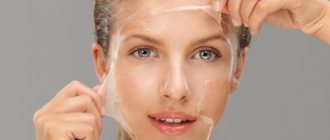The widespread use of chemical peeling in recent years is explained by the relative safety and simplicity of the procedure, and most importantly, its effectiveness. Deep peeling has become especially popular, radically changing the appearance of the skin. This method of rejuvenation and elimination of aesthetic defects is comparable in results to plastic surgery. But how harmless this operation is, what risks may arise when performing it, and whether it can be done at home, we will tell you in this article.
What is deep peeling?
Deep chemical peeling is practically a plastic surgery, as it is performed under anesthesia. The main component in the procedure is phenol, an extremely toxic organic compound that, if used incorrectly, can become a real murder weapon. The entry of carbolic acid into the blood can cause serious problems with the liver and kidneys, and sometimes even death.
However, do not be alarmed; you need to know this in order to be careful when choosing clinics and specialists who perform chemical peeling. You should not do the procedure at home; it is better to trust the professionals.
Deep peeling is a complex, painful procedure that requires subsequent rehabilitation for up to six months.
Numerous age-related changes occurring in the epidermis, as a rule, occur after the age of 40 years. This is one of the most common reasons to do a deep chemical peel. The procedure allows you to eliminate freckles, moles, eliminates hyperpigmentation, benign neoplasms, as well as subcutaneous formations.
With the help of peeling, you can remove scars, traces of acne and vaccinations, shallow wrinkles, and stimulate the production of elastin and collagen in the skin. According to experts, the duration of the effect of the operation is 7-10 years.
Contraindications
Any medical and cosmetic procedure has contraindications, especially something as serious as deep peeling of the facial skin. It is not recommended to do this if you have:
- any skin problems, including allergic rashes and open wound surfaces,
- tumors and neoplasms in the body,
- any diseases of the blood, blood vessels and heart,
- tendency to the appearance of keloid scars on the skin,
- problems with the endocrine system,
- acute renal and liver failure,
- tendency to develop convulsions and epileptic seizures,
- increased thinness and sensitivity of facial skin,
- inflammatory processes and infections in the body.
In addition, you should not use deep facial peeling during pregnancy and breastfeeding, as well as for people under 25 years of age. Do not resort to this method of rejuvenation and facial cleansing during menstruation and other hormonal imbalances in the body, as well as in old age.
Features of superficial chemical peeling
For example, almond peeling is one of the types of chemical surface peeling, the basis for which is fruit acids.
Almond peeling is a superficial chemical peel. It affects the upper stratum corneum of the skin before reaching the vitreous layer. The composition of almond peeling mainly includes mandelic acid, 2-hydroxy-2-phenylacetic acid or phenylglycolic acid, which belongs to alpha hydroxy acids (they are often called fruit acids), obtained by hydrolysis from bitter almond extract.
It should be noted that it is not advisable to do almond peeling at home. First of all, a cosmetologist must determine the indications for such procedures and carefully monitor the process.
The peeling procedure itself includes several mandatory steps, on which the final result depends. First, the face is cleansed with milk containing 10% mandelic acid. Then a special composition of acids is applied to the skin, which helps determine the presence of allergic reactions in a person. After this, the peeling itself, which contains at least 30% of the active substance, is applied with massaging movements.
After 10 minutes, the product should be thoroughly rinsed with water. A soothing mask and moisturizer complete the process. After the procedure, the skin should be intensively moisturized for about a week, and before going outside, use sunscreen. The course can last from 6 to 10 procedures, the interval between them should be no more than 10 days, but the effect will be noticeable after the first sessions.
During the post-peeling period, in order to avoid discomfort and prolong the effect, it is necessary to use various auxiliary products that the cosmetologist will recommend.
These can be soothing masks, moisturizing and nourishing creams for home care.
It should be noted that almond peeling can cause some complications that can be easily eliminated with the right approach:
- Dryness and burning sensation that goes away after applying a moisturizer.
- Redness is eliminated with moisturizers.
- The skin may peel, which can be corrected with almond cream.
- More serious complications, which very rarely occur after such procedures, can be eliminated by a cosmetologist. Swelling of the skin, for example, is eliminated with hormonal ointments. Indications for the use of certain drugs must be agreed with a specialist.
Almond peeling deservedly justifies its growing popularity every day. There are many reviews about its successful use in cosmetology. After peeling, the skin becomes noticeably fresher and cleaner, feeling soft and smooth. The complexion improves, the pores narrow and the skin tone increases.
In addition, almond peeling can be used not only on the face, but also on the skin of the hands and décolleté. This is one of the most effective methods of combating age-related changes in the skin, activating its renewal. It has been proven that mandelic acid stimulates the synthesis of its own collagen and improves skin structure, which is why it has such a beneficial effect on mature skin.
Kinds
In cosmetology, there are numerous variations of facial peels. They differ not only in the active ingredients, but also in the technologies used. In this section we will introduce you to hardware and acid types. Let's tell you how they are effective and what they are used for.
Hardware
The effect of hardware peeling is achieved by exposing skin cells to a laser or radio wave, causing them to evaporate (ablation). In this case, heat does not penetrate into neighboring tissues, which eliminates the occurrence of scars and other complications after the procedure.
- An anesthetic solution is injected into the skin area and thoroughly moistened with saline solution.
- After which the doctor treats the skin with a laser or radio wave.
- The procedure lasts about an hour, upon completion the face is treated with Vaseline or emollient cream.
We recommend: All about washcloths for body exfoliation. Types, features, advantages
A day after the procedure, swelling appears, which disappears on the sixth or seventh day. During healing, the skin is treated with a softening cream. On the fourth day, a scab appears from the procedure, which disappears on the 10th day. If postoperative erythema occurs, the skin is treated until it disappears. To do this, use creams with a high degree of ultraviolet protection.
Acid
For acid peeling, one or more acids are used. Acid affects the skin at the molecular, cellular and tissue level. Has exfoliating, regenerating and antioxidant effects. The acid destroys the intercellular connections between the cells of the stratum corneum, which leads to the synthesis of collagen and elastin. Acids that may be included in deep peeling:
- milk – having a keratolytic effect, moisturizes the skin;
- almond – the large size of its molecules reduces photosensitivity and whitens the skin;
- retinoic – enhances the synthesis of immune cells and improves tissue hydration;
- glycolic – used in the self-rejuvenation method and as a preparatory stage for serious procedures;
- salicylic acid – used in the treatment of acne.
Acid peeling normalizes the functioning of the sebaceous glands, activates the protective properties of the skin and promotes regeneration.
How is deep facial peeling performed?
The phenol peeling procedure is preceded by a therapeutic course necessary to prevent the development of herpetic and antibacterial infections. The pain of the operation requires the mandatory use of general painkillers. Typically, a 2% lidocaine solution is used as an anesthetic. Particular attention should be paid to calculating the dose of the drug, since it increases the level of toxicity of phenol and is neutralized by liver enzymes.
Preparing your face for peeling involves carefully removing dead skin cells with soap. Then the dried skin is additionally treated with acetone and alcohol for degreasing purposes.
Carrying out phenol peeling must be coordinated with a cosmetologist, who determines the individual characteristics of the skin and its condition at the time of the procedure.
Phenol peeling is applied to the face zonally, taking into account the structure of different areas of the skin. This is followed by covering the treated leather with a special film, onto which, after drying, geloleo is applied, a preparation resembling wax. It contains "hidden" phenol.
By reacting with the film, geleo “releases” phenol and acts on those areas of the skin where the activity of the first layer is insufficient. In this way, the process of self-regulation of depth by phenol peeling is launched. This complex mask remains on the face for 48 hours. It is almost impossible to make such a mask on your own at home.
Cost of the procedure in Moscow and St. Petersburg
The price for deep facial peeling using a laser is high, but as reviews from those who have decided to undergo this procedure show, the result is worth it. In Moscow, this amount varies between 10,000-20,000 rubles, as in St. Petersburg, depending on the location of the clinic or salon, their status and some other factors.
Of course, you can save a lot and cleanse your facial skin at home using products you prepare yourself or buy in a store or pharmacy. But such an approach will not only not provide a good result, but will also not be safe. Indeed, in each specific case, a different approach is needed so as not to harm the skin and not injure it, leaving ugly scars and cicatrices. Laser deep facial peeling is done only in stationary conditions and allows you to achieve maximum results in cleansing the skin and rejuvenating it. This is an absolutely safe and effective method that will allow your skin to become more beautiful, younger and maintain the effect for a long time.
Rehabilitation period
The presence of a phenol mask on the face is marked by severe pain, which requires the administration of certain painkillers. In addition to a burning sensation and tingling sensation on the skin, the movement of the facial muscles is limited as much as possible. During the first 72 hours, contact of the patient’s face with water is unacceptable: you can drink only with a straw, and brush your teeth without rinsing your mouth.
After two days, the cosmetologist carefully removes the phenol mask with a plastic spatula. The softened layer of epithelium also comes off with it. A bright red surface covered with wounds is formed. After 24 hours, fibrin is applied to the bleeding area, causing the skin to turn greenish. At this stage, the cosmetologist allows patients to wash themselves with water.
On the 10th day, fibrin films peel off, revealing fresh, young, pink skin. After three weeks, the renewed skin can already be powdered, although redness remains for two months, and its full maturation will take about six months.
The professional series for post-peeling care consists of several active masks
- Retexturize Mask with pumpkin –
- Revitalize Mask with papain (papaya enzyme), honey and fruit-citrus composition.
- Hydrate Mask with oat milk –
therapeutic mask with enzymes for exfoliation, smoothing, restoration and hydration. Rejuvenates, stimulates regeneration. Our cosmetologists use it to care for oily, atonic, dull skin.
Gives elasticity, velvety, uniform shade, soothes and softens. Due to the strong antioxidants included in the formula, it carefully eliminates inflammation and normalizes the skin's hydrobalance. Strengthens the effect of rejuvenation and smoothing of the skin.
We use it for active moisturizing. It also contains arnica and cucumber flower extract, D panthenol. The drug soothes, softens, eliminates redness and reactivity of the skin after peeling.
Risks of Chemical Peels
When in contact with the skin, phenol, used in deep peeling, interacts with plasma protein and damages blood vessels. Thus, the substance entering the blood can provoke arrhythmia.
The concentration of phenol in the patient’s blood is influenced by the following factors:
- percentage of the substance in the peeling mass;
- work area size;
- speed of application of the composition to the skin;
- time of penetration of phenol into the body through the skin;
- the rate of breakdown of a substance in the body.
The behavior of phenol in the human body is comparable to a nephrotoxic poison that poisons the kidneys. The substance can cause death in large doses, but the amount in preparations intended for deep peeling is very small. In the liver, phenol is converted into a life-safe compound and then excreted by the kidneys.
Deep chemical peeling is practically plastic surgery, since this procedure is performed under general anesthesia.
It follows that for diseases of the kidneys, liver, or heart, chemical peeling is contraindicated. Deep facial peeling with phenol is strictly prohibited for pregnant women, people with cancer and chronic skin diseases (eczema, psoriasis, acne).
Differences between simple and deep skin peeling
There are several types of skin peeling, some of which you can do at home yourself, and some of which are used only in a beauty salon or cosmetology clinic. Here are the most commonly used ones:
- Peeling using abrasives. They are usually made from grape or apricot seeds, coffee grounds, ground almonds and others. In this case, the size of the solid particles determines how soft or harsh the product acts on the skin.
- Acid peeling. This is done using fruit acids and acid-based products purchased at the pharmacy.
- Soft ready-made formulations without abrasive particles, for example, gels and foams for washing.
- Vacuum or ultrasonic facial cleansing.
- Laser peeling. There are several types: superficial, medium and deep - depending on the depth of penetration of the laser beam into the skin layers.
A simple peeling will help you get rid of dead skin cells, cleanse your face of impurities and refresh your color. With its help, the skin will become smoother and the pores less pronounced. About painless and safe.
Deep facial peeling with a laser, unlike simple peeling, solves more global problems. It not only smooths out wrinkles and cleanses the face of minor imperfections, but also corrects the shape of the face, heals and rejuvenates the skin as a whole. Its results are more obvious and visible to the naked eye, and the duration of their preservation is much longer. It is not painless and is performed with anesthesia, but it is also safe.
Side effects of the procedure
In addition to the positive benefits, deep chemical peeling has a number of possible side effects:
- increased signs of allergies (in allergy sufferers);
- exacerbation of the herpes virus;
- the appearance of a third degree burn on the skin of the face, which will require protection from sunlight throughout life;
- kidney dysfunction;
- the occurrence of arrhythmia;
- loss of the skin's ability to produce pigment;
- susceptibility to the development of infectious diseases.
If you still decide to look 10 years younger, are not afraid of a long and difficult recovery period and have the opportunity to be minimally exposed to sunlight, then go for it. But remember, the success of the procedure and its safety can only be ensured by an experienced dermatocosmetologist and strict adherence to all his recommendations. Well, if deep peeling seems like a risky idea to you, you can always choose a safer and more affordable rejuvenation procedure.
Types of facial peeling
Peeling is not a new procedure in cosmetology, but it is so popular and loved by clients. Specialists are introducing new types of peeling and improving skin care methods.
There are different types of peeling based on depth and method of exposure. According to depth they are distinguished:
- Superficial peeling – affects only the top layer of the epidermis. Effective for enlarged pores, small defects, grade 1-2 acne.
- Medium peeling is used to correct age-related changes (wrinkles, sagging skin folds, bags under the eyes) and imperfections after acne (post-acne marks).
- Deep peeling - the chemical effect of the drug helps eliminate age spots, deep wrinkles and scars, and create a powerful lifting. This is an aggressive procedure that is performed under anesthesia and requires long-term rehabilitation.
According to the degree of impact, peeling is divided into mechanical, physical (ultrasound, laser), diamond, fruit (it is also called “vegetable”). The differences are in the mechanics of the procedure and the means used.
At the moment, there are more than 50 types of peeling, and with the right selection and compliance with all requirements, this procedure can transform your skin.
Indications and contraindications
Deep peeling is recommended for people who have the following skin problems:
- withering and flabbiness;
- wrinkles and other signs of skin aging;
- old scars and scars from injuries, operations, acne marks;
- color disturbance - yellow, gray, red skin, sallow;
- increased pigmentation;
- stretch marks;
- loose skin;
- seborrhea;
- ingrown hairs;
- acne;
- pimples, acne and pimples.
As a rule, the procedure is performed once in a lifetime, as it has a long-lasting effect.
Deep peeling is recommended for people over 50 years of age. The procedure is suitable for patients with fair skin, because on dark or dark skin the boundaries between the new skin formed after the procedure and the old one will be too noticeable, the face will look much lighter and paler. However, there are a large number of circumstances in which deep chemical peeling is not only undesirable, but even dangerous:
- herpes;
- pregnancy;
- hypertension;
- taking certain medications, for example, antipsychotics, retinoids, estrogens;
- lactation;
- open wounds, abrasions, scratches and ulcers;
- depigmented spots;
- diseases of the liver, kidneys and blood;
- inflammation and irritation, redness on the skin;
- oncological diseases;
- diabetes;
- tanned skin;
- warts;
- cold, fever, high temperature;
- somatic diseases;
- thyroid diseases;
- critical days;
- increased skin sensitivity, thinning of the skin;
- close location of vessels, veins and capillaries to the surface of the skin (vascular networks);
- epilepsy and other diseases accompanied by seizures.
Deep peeling is not performed on persons who have hypersensitivity, individual intolerance, or allergies to the active components of the substance used. Also, the procedure is not carried out in the summer and spring months, since exposure to ultraviolet radiation negatively affects the results obtained and can slow down the process of skin restoration.
Peeling at home
Fortunately, you don't have to go to a salon to deep cleanse your face. There are much simpler, safer and gentler ways to cleanse your skin that you can do at home.
Industrial products
The modern beauty industry offers many products for home peeling. They are designed for women who do not have the time or opportunity to visit beauty salons. With such compositions, the cleansing procedure can be carried out quickly and easily at home.
Companies producing deep peeling products:
- PREMIUM Professional (Russia)
- Bb Laboratories (Japan)
- ADJUPEX (Japan)
- Skin Doctors (Australia)
- NeoStrata (USA)
- BeautyMed(France)
Of course, peeling with products intended for home use is not similar to a salon procedure. Industrial formulations for home procedures are much softer and safer. They do not contain phenol, but they do contain more delicate components - AHA acids, glycolic acid, azelaic acid. They do not destroy the dermis to the ground, but only renew the surface layer and clean out impurities from the pores. Nevertheless, even such a procedure can greatly transform the skin, making it smoother and cleaner. Home peeling is ideal for young skin that does not require serious treatment.
Home Recipes
Homemade compositions made from improvised products are inferior in effectiveness to store-bought and salon peelings, but are absolutely safe. Home cleansing needs to be repeated regularly and quite often, only then will it give good results.
One of the most popular homemade formulations that cleanses the skin quite deeply is AHA acid (or fruit acid) peeling.
Most often used:
- Apple acid;
- lactic acid;
- lemon acid;
- glycolic acid;
- wine acid;
- salicylic acid.
In addition, calcium chloride is often used for home cleansing. It is sold in pharmacies. It is applied to the face with a tampon; in places with rougher and thicker skin, more acid needs to be applied.
And yet, for self-cleansing, it is better to choose proven “grandmother’s” recipes.
Classic peeling
You will need:
- boric acid – 10 grams;
- ammonia (10%) – 10 grams;
- glycerin – 30 ml;
- camphor alcohol – 30 ml;
- hydrogen peroxide – 30 ml;
- hydroperite – 2 tablets;
- baby soap – 1-2 spoons.
Mix camphor alcohol and glycerin in a glass bowl, add ammonia, then boric acid, hydroperite and peroxide. Add a few tablespoons of grated soap to the finished mixture. You need to add soap gradually, stirring the mixture to get a mass that resembles a cream in consistency.
This mask should be applied to the face and washed off after it has completely dried. The composition can be stored in the refrigerator for 90 days.
Salt peeling
You will need:
- salt – 1 spoon;
- soda – 1 spoon;
- any face cream – 1 spoon.
Mix the ingredients and apply the mixture to your face. Keep it on for 20 minutes and then rinse with water. If the mask begins to pinch and burn the skin, it must be washed off immediately.
This peeling is best suited for cleansing oily, porous and acne-prone skin at home.
Salicylic peeling
You will need:
- aspirin – 3 tablets;
- base (kefir, yogurt, soft cottage cheese) – 0.5 spoons;
- honey – 0.5 spoons.
Add crushed aspirin tablets to the base, let the mixture stand for a few minutes and then stir in honey.
Apply peeling to cleansed face and leave for 10-15 minutes. A slight tingling sensation may occur.
Let us remind you that all home compositions cannot be called deep. They are stronger and more effective than conventional home scrubs, but are significantly inferior in effectiveness to salon procedures. Home cleansing falls into the category of superficial and medium peels, since it does not destroy the deep layers of skin to create new skin.

